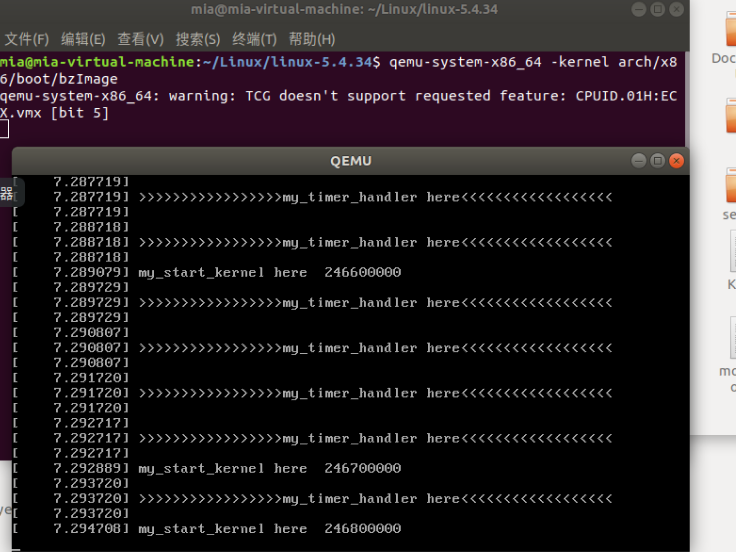基于mykernel2.0 编写一个操作系统内核
一、实验要求
- 按照https://github.com/mengning/mykernel 的说明配置mykernel 2.0,熟悉Linux内核的编译;
- 基于mykernel 2.0编写一个操作系统内核,参照https://github.com/mengning/mykernel 提供的范例代码
- 简要分析操作系统内核核心功能及运行工作机制
二、实验目的
- 理解Linux操作系统内核工作原理;
- 理解进程调度和中断机制
三、实验环境
mac OS 15.4+Vmare Funsion + Ubuntu 18.04.1 LTS
四、实验步骤
1.下载mykernel并编译
在终端依次执行下述命令
wget https://raw.github.com/mengning/mykernel/master/mykernel-2.0_for_linux-5.4.34.patch sudo apt install axel axel -n 20 https://mirrors.edge.kernel.org/pub/linux/kernel/v5.x/linux-5.4.34.tar.xz xz -d linux-5.4.34.tar.xz tar -xvf linux-5.4.34.tar cd linux-5.4.34 patch -p1 < ../mykernel-2.0_for_linux-5.4.34.patch sudo apt install build-essential gcc-multilib libncurses5-dev bison flex libssl-dev libelf-dev sudo apt install qemu # install QEMU make defconfig # Default configuration is based on 'x86_64_defconfig' make -j$(nproc)
在这有一个错误需要注意一下:(最开始使用Cent os做的,这是遇到的问题之一:,放弃的原因是因为之前装的Cent os没界面,无法启动qemu)

解决方案:
Ubuntu:
apt install libelf-dev
apt install libssl-dev
CentOS:
yum install elfutils-libelf-devel
2.启动mykernel
qemu-system-x86_64 -kernel arch/x86/boot/bzImage
在执行了该命令后,会弹出如下一个窗口:可以看到mymain.c的代码在不停的执行的同时,会有一个周期性的时钟中断信号来触发myinterrupt.c的代码。

打开mymain.c和myinterrupt.c两个源代码可以看到,mymain.c中每100000计数输出my_start_kernel here,myinterrupt.c每200000计数输出my_timer_handler here。当前有一个CPU执行C代码的上下文环境,同时具有中断处理程序的上下文环境,我们通过Linux内核代码模拟了一个具有时钟中断和C代码执行环境的硬件平台。
void __init my_start_kernel(void) { int i = 0; while(1) { i++; if(i%100000 == 0) pr_notice("my_start_kernel here %d ",i); } } void my_timer_handler(void) { pr_notice(" >>>>>>>>>>>>>>>>>my_timer_handler here<<<<<<<<<<<<<<<<<< "); }
3. 编写一个操作系统内核3.1定义进程控制块(PCB)
既然要内核控制进程,那就要为进程设计一个数据结构来存储进程的信息,如下是PCB(进程控制块)的定义:
mypcb.h
#define MAX_TASK_NUM 4 #define KERNEL_STACK_SIZE 1024*2 /* CPU-specific state of this task */ struct Thread { unsigned long ip; unsigned long sp; }; typedef struct PCB{ int pid; volatile long state; /* -1 unrunnable, 0 runnable, >0 stopped */ unsigned long stack[KERNEL_STACK_SIZE]; /* CPU-specific state of this task */ struct Thread thread; unsigned long task_entry; struct PCB *next; }tPCB; void my_schedule(void);
3.2修改mymain.c
在修改程序代码之前先对内联汇编代码进行一下解释:
asm volatile( "movq %1,%%rsp " /* 将进程原堆栈栈顶的地址存⼊RSP寄存器 */ "pushq %1 " /* 将当前RBP寄存器值压栈 */ "pushq %0 " /* 将当前进程的RIP压栈 */ "ret " /* ret命令正好可以让压栈的进程RIP保存到RIP寄存器中 */ : : "c" (task[pid].thread.ip),"d" (task[pid].thread.sp) /* input c or d mean %ecx/%edx*/ );
movq %1,%%rsp 将RSP寄存器指向进程0的堆栈栈底,task[pid].thread.sp初始值即为进程0的堆栈栈底。
pushq %1 将当前RBP寄存器的值压栈,因为是空栈,所以RSP与RBP相同。这⾥简化起⻅,直接使⽤进程的堆栈栈顶的值task[pid].thread.sp,相应的RSP寄存器指向的位置也发⽣了变化,RSP = RSP - 8,RSP寄存器指向堆栈底部第⼀个64位的存储单元。
pushq %0将当前进程的RIP(这⾥是初始化的值my_process(void)函数的位置)⼊栈,相应的RSP寄存器指向的位置也发⽣了变化,RSP = RSP - 8,RSP寄存器指向堆栈底部第⼆个64位的存储单元。
ret将栈顶位置的task[0].thread.ip,也就是my_process(void)函数的地址放⼊RIP寄存器中,相应的RSP寄存器指向的位置也发⽣了变化,RSP = RSP + 8,RSP寄存器指向堆栈底部第⼀个64位的存储单元。
修改mymain.c中的my_start_kernel函数,并在其中实现了my_process函数,作为进程的代码模拟一个个进程,时间片轮转调度。
/* * linux/mykernel/mymain.c * Kernel internal my_start_kernel */ #include <linux/types.h> #include <linux/string.h> #include <linux/ctype.h> #include <linux/tty.h> #include <linux/vmalloc.h> #include "mypcb.h" tPCB task[MAX_TASK_NUM]; tPCB * my_current_task = NULL; volatile int my_need_sched = 0; void my_process(void);//模拟进程执行代码 void __init my_start_kernel(void) { int pid = 0;//0号进程 int i; /* 初始化0号进程PCB信息*/ task[pid].pid = pid; task[pid].state = 0;/* -1 unrunnable, 0 runnable, >0 stopped */ //任务入口地址,将my_process的地址赋给ip task[pid].task_entry = task[pid].thread.ip = (unsigned long)my_process; //0号进程PCB堆栈栈顶地址赋给sp task[pid].thread.sp = (unsigned long)&task[pid].stack[KERNEL_STACK_SIZE-1]; //系统刚开始只有一个进程,下一个进程地址指向自身 task[pid].next = &task[pid]; /*fork more process */ //复制0号进程创建更多进程,并对它们赋值,插入队列 for(i=1;i<MAX_TASK_NUM;i++) { memcpy(&task[i],&task[0],sizeof(tPCB)); task[i].pid = i; task[i].thread.sp = (unsigned long)(&task[i].stack[KERNEL_STACK_SIZE-1]); task[i].next = task[i-1].next; task[i-1].next = &task[i]; } /* start process 0 by task[0] */ //启动0号任务,开始执行0号进程 pid = 0; my_current_task = &task[pid];//当前任务指针 /*下面这一段是进程执行的关键汇编代码,下文会对其进行详细分析 * %1指task[pid].thread.sp,%0指task[pid].thread.ip */ asm volatile( "movq %1,%%rsp " /* set task[pid].thread.sp to rsp */ "pushq %1 " /* push rbp */ "pushq %0 " /* push task[pid].thread.ip */ "ret " /* pop task[pid].thread.ip to rip */ : : "c" (task[pid].thread.ip),"d" (task[pid].thread.sp) /* input c or d mean %ecx/%edx*/ ); } int i = 0; //模拟进程执行过程,这⾥采⽤的是进程运⾏完⼀个时间⽚后主动让出CPU的⽅式。 void my_process(void) { while(1) { i++; if(i%10000000 == 0) { printk(KERN_NOTICE "this is process %d - ",my_current_task->pid); if(my_need_sched == 1)//判断是否需要调度 { my_need_sched = 0; my_schedule();//执行调度 } printk(KERN_NOTICE "this is process %d + ",my_current_task->pid); } }
void __init my_start_kernel(void)函数是mykernel内核代码的⼊⼝,负责初始化内核的各个组成部分。在Linux内核源代码中,实际的内核⼊⼝是init/main.c中的start_kernel(void)函数。
在my_process函数的while循环里面可见,会不断检测全局变量my_need_sched的值,当my_need_sched的值从0变成1的时候,就需要发生进程调度,全局变量my_need_sched重新置为0,执行my_schedule()函数进行进程切换。
3.3修改myinterrupt.c
先对其中的数据结构进行解释:
asm volatile( "pushq %%rbp " /* save rbp of prev */ "movq %%rsp,%0 " /* save rsp of prev */ "movq %2,%%rsp " /* restore rsp of next */ "movq $1f,%1 " /* save rip of prev */ "pushq %3 " "ret " /* restore rip of next */ "1: " /* next process start here */ "popq %%rbp " : "=m" (prev->thread.sp),"=m" (prev->thread.ip) : "m" (next->thread.sp),"m" (next->thread.ip) );
pushq %%rbp 保存prev进程(本例中指进程0)当前RBP寄存器的值到prev进程的堆栈;
movq %%rsp,%0 保存prev进程(本例中指进程0)当前RSP寄存器的值到prev->thread.sp,这时RSP寄存器指向进程的栈顶地址,实际上就是将prev进程的栈顶地址保存;%0、%1...指这段汇编代码下面输入输出部分的编号。
movq %2,%%rsp 将next进程的栈顶地址next->thread.sp放入RSP寄存器,完成了进程0和进程1的堆栈切换。
movq $1f,%1 保存prev进程当前RIP寄存器值到prev->thread.ip,这里$1f是指标号1,恢复进程后从此执行。
pushq %3 把即将执行的next进程的指令地址next->thread.ip入栈。
ret 就是将压入栈中的next->thread.ip放入rip寄存器,rip寄存器现在存储next进程的指令。
1: next 进程开始执行的位置。
popq %%rbp 将next进程堆栈基地址从堆栈中恢复到RBP寄存器
修改源代码:
/* * Called by timer interrupt. * it runs in the name of current running process, * so it use kernel stack of current running process */ void my_timer_handler(void) { if(time_count%1000 == 0 && my_need_sched != 1)//设置时间片的大小,时间片用完则开始调度 { printk(KERN_NOTICE ">>>my_timer_handler here<<< "); my_need_sched = 1;//设置进程调度标志 } time_count ++ ; return; } //调度函数 void my_schedule(void) { tPCB * next;//下一个进程指针 tPCB * prev;//当前进程指针 if(my_current_task == NULL || my_current_task->next == NULL) { return; } printk(KERN_NOTICE ">>>my_schedule<<< "); /* schedule */ next = my_current_task->next;//下一个进程 prev = my_current_task;//当前进程 if(next->state == 0)/* -1 unrunnable, 0 runnable, >0 stopped */ { my_current_task = next; //排队策略 printk(KERN_NOTICE ">>>switch %d to %d<<< ",prev->pid,next->pid); /* 进程切换 */ //下面是进程切换的汇编代码,下文将进行详细分析 asm volatile( "pushq %%rbp " /* save rbp of prev */ "movq %%rsp,%0 " /* save rsp of prev */ "movq %2,%%rsp " /* restore rsp of next */ "movq $1f,%1 " /* save rip of prev */ "pushq %3 " "ret " /* restore rip of next */ "1: " /* next process start here */ "popq %%rbp " : "=m" (prev->thread.sp),"=m" (prev->thread.ip) : "m" (next->thread.sp),"m" (next->thread.ip) ); } return; }
mykernel提供了时钟中断机制,周期性执行my_time_handler中断处理程序,该函数定时观察my_need_sched是否不等于1,如果是则将其置为1,使myprocess执行my_schedule()。
my_schedule函数在PCB环形队中选择下一个进程进行执行,但对于处于不同状态的进程,调度方式略有不同,如果即将上CPU的进程之前已经运行过(即state为0),我们保存当前进程的信息,然后把下一个进程的信息写入到寄存器中,执行ret使下一个进程开始执行。
之前没有在运行态的(state不为0),我们先将其设置为运行态,我们这里需要初始化其ebp,因为该进程的堆栈是空栈esp=ebp。
3.4再次编译、运行
make defconfig # Default configuration is based on 'x86_64_defconfig' make -j$(nproc) qemu-system-x86_64 -kernel arch/x86/boot/bzImage

实验总结:
通过这次编写一个操作系统内核的实验,让我了解了进程切换调度的过程,在进程切换调度过程中,需要先保存当前进程的上下文环境,然后加载需要调度的进程执行环境。在这个过程中,需要结合进程堆栈,esp堆栈栈顶指针寄存器,ebp堆栈栈底指针寄存器以及eip指令寄存器来共同完成。